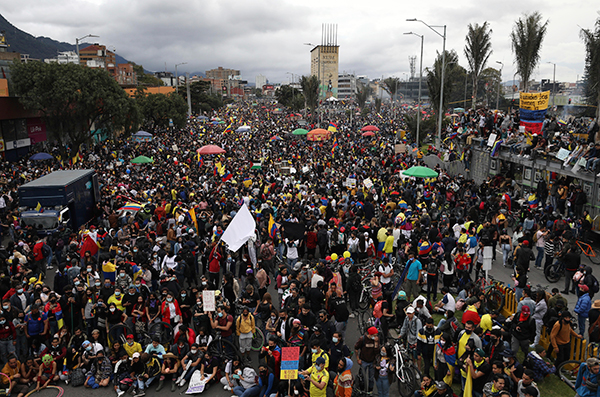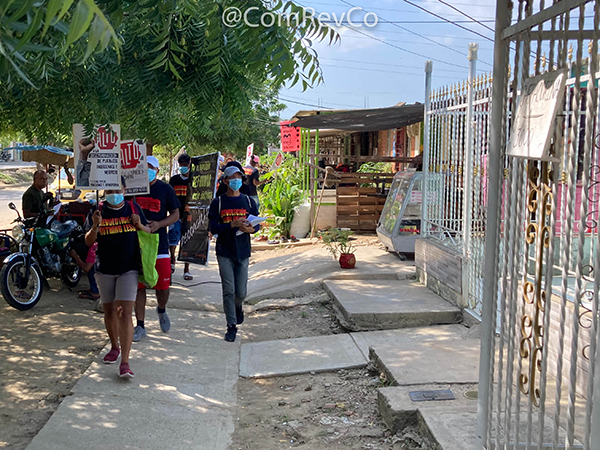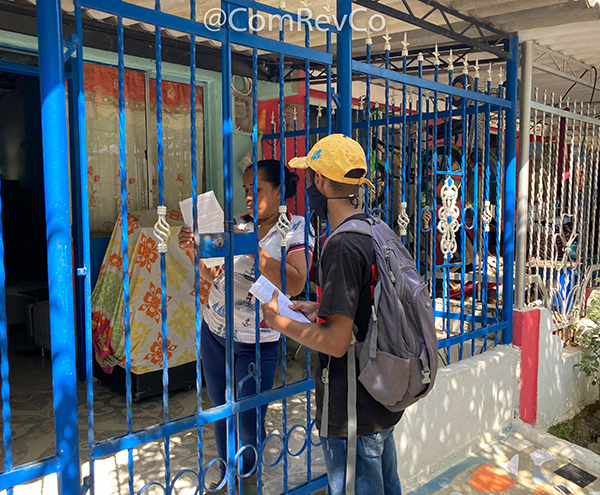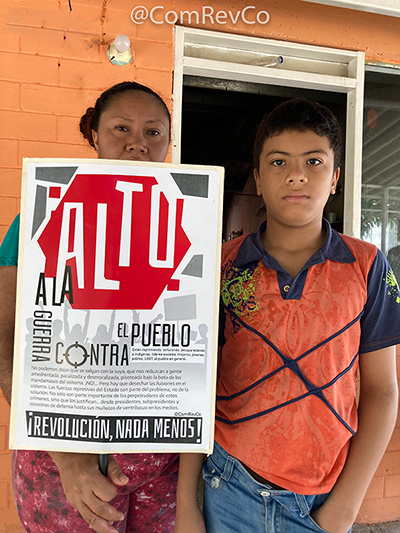Translation by revcom.us
From the Revolutionary Communist Group, Colombia:
More and More Reasons to Rebel!
| revcom.us
Editors’ Note: Revcom.us received this analysis and account of recent developments with the current mass upsurge in Colombia from the Revolutionary Communist Group, Colombia. We felt these edited excerpts would be of interest to our readers. (Go here for previous news coverage at revcom.us.)
As we write this, the mobilizations of the National Strike that began on April 28 continue in Colombia, challenging what is a de facto state of siege. [Colombian president Iván] Duque’s fascist regime (continuation of “Uribato” [reference to the regime of former Colombian president Uribe]) has militarized the main cities of the country, they are mobilizing their social base and paramilitary groups, while they have taken the muzzles off the police, driving them to use all their strength against unarmed protesters.
While they insist on criminalizing the righteous mass mobilizations as “vandalism” and “terrorism,” the criminal former president Álvaro Uribe and his Democratic Center party characterize the strike as a “dissipated molecular revolution” and the protest as a military target and have called for “unrestricted support” for the murderous police and for a “forceful and sustained military action.” They are preparing a (bigger) slaughter.
Twelve days after the start of the protests, there are about fifty dead, hundreds injured, many of them seriously; multiple cases of sexual violence against female protesters, more than a hundred disappeared, and more than a thousand arbitrarily detained and tortured during these detentions.
Although the protests have extended to more than 200 cities and towns, they have had greater strength and belligerence in Cali (in the southwestern part of the country), and in particular in the Aguablanca district and in Siloé (where many people remember when, in 1985, the Army entered with blood and fire in a brutal hunt for members of the M-19 [April 19 Movement]), barrios of masses with a high density of black population.
With the arrival of the indigenous “Minga” [protest movement] from the neighboring department of Cauca to support the protests, the well-known racism of the elites in the southwest of the country (and from here and there beyond that) has also been exacerbated.
The spontaneous and righteous mobilizations of hundreds of thousands and the fury of millions due to the crimes of the system have not been pacified with the brutal repression, part of a real war against the people, but, on the contrary, in a section of the people this has further fired up the desire to put an end to the horrors generated by this horrific system.
Although small, there have been important actions by revolutionary communists who have participated in the mass actions, leafleting massively, covering walls with posters, distributing revolutionary literature, and calling for revolution and nothing less than that.
But the magnitude of the uprising and its impact have stirred up a series of interpretations, with little accuracy, about the source, motivations or character of the protests, increasing the confusion among broader sections of the people, which makes it necessary, in the midst of the struggle, to discuss the aspects which make it possible to properly assess the situation and feed into the understanding of the organized or not organized fighters, in order to draw lessons for future struggles, with higher sights, in terms of a true revolution:
• This goes beyond taxes on the poorest people, this also goes beyond two sides demonstrating their power in a pitched battle, with police going outside their mandate and using their weapons against the civilian population on the one hand, and on the other hand, “the delinquents destroying everything in their way” and that, according to the conspiracy theories put forward by the government and its courtesans, could be being financed by “groups outside the law” (drug traffickers, FARC [Revolutionary Armed Forces of Colombia, revisionist guerrilla group] dissidents) and the governments of Venezuela and Cuba.
• Not a few analysts have identified the problems to some extent: There is a direct causal connection between the protest and the monstrous increase in hunger, the collapse of the middle class, unemployment, poverty, despair among the young, in addition to the poor handling of the pandemic by the government. Those are the underlying causes of the societal mobilization which has paralyzed the country. It was inevitable that, given the accumulation of discontent, the anger against the government would burst out in the streets with a slight provocation such as the tax reform. (Gabriel Silva [journalist]). Young people have been clear protagonists in the marches and protests. Of the 10.9 million young people that DANE [National Statistics Department] estimates that are in Colombia, a third of young people neither work nor study. Just in Bogotá, with the pandemic, the population of young people in this situation doubled; today there are 665,000. Youth unemployment in the capital [Bogotá] is 29.9%. Thousands of young people either lost their jobs or had to stop studying because their parents left the job market and they had no way to pay for their studies. (Juan C. Flórez [journalist])
• As we pointed out a few months ago: “The current pandemic has worsened the shameful situation for the vast majority of the people [in 2020 poverty increased by 6.8 points, to 42.5% of the population]. And the handling of the pandemic has done nothing but worsen it even more... The rebellious response of the masses is a continuation of what was happening before the ‘pause’ of the pandemic. But the repression has not paused... The uprisings in response have also not ‘paused.’ Between November 21, 2019 and February 21, 2020, there were 24 days of struggle in dozens of cities. The massacres in Cali and Samaniego unleashed a resumption of protests in August and, after the murder of Javier Ordόñez by the police, there was a new uprising, mainly in Bogotá on September 9 and 10, in the face of which the state very brutally murdered 13 young people. (Already in March in Bogotá, 23 people had been murdered in the massacre at the Modelo prison)... Concentrations of contradictions, ‘cracks’ or ‘fault lines’ in Colombian society... are at a point which can lead to a big righteous outbreak of the masses.” (“It’s Right to Rebel! Rebel Against the System!,” Revolutionary Communist Group of Colombia, October 21, 2020)
• In Colombian society there are concentrations of contradictions that within this system are impossible to resolve in favor of the interests of the masses of people and of society as a whole, constituting cracks—fractures or fissures—not only in the façade but throughout the whole base of current society:
- The impoverishment, unemployment and moral and intellectual degradation of the people
- The war against the people, massacres, forced displacement, and the criminalization of young people
- Discrimination and oppression of indigenous and black peoples and all kinds of racism and xenophobia
- The degradation, dehumanization and patriarchal subjugation of women and all oppression based on sexual or gender orientation
- The stifling and persecution of dissent and critical and scientific thinking, and the promotion of all kinds of superstition
- The domination of imperialism, food dependency and wars for empire
- Degradation and destruction of the environment
If you look below the surface, you can see how underneath the current crisis in the country, these different cracks can be identified, with greater or lesser sharpness.
• Among certain sections of the masses, particularly young people and women, an element of active rejection is developing, of determined opposition to the political program of the reactionaries. There is not yet a situation of open or widespread rebellion in the country beyond the ongoing belligerent protests, but the cracks in the façade have begun to appear. In the struggle to put an end to each and all the outrages of the different cracks, there is also the potential for a truly revolutionary transformation, if those struggles are brought together in a single knot towards the goal of building a completely different and better society.
• There is an intense struggle within the ruling classes over how to lead a country like Colombia (dominated by imperialism, with a distorted and disarticulated economy) that is and has been a key link in the regional dominance of the United States. The Uribista [former Colombian president] regime has almost absolute control of the state, including what have been some alleged bodies of control. Their illegitimacy in the eyes of the masses has grown, although they still have a strong mass base and the backing of fascist sections among the military and the police. They are consolidating their social base to respond violently in a likely show of force. They are preparing to stay in power at any cost.
• It can be said that “there will be radical change,” but “will it be emancipatory, or enslaving—revolutionary, or reactionary?” In the midst of the sharpening of societal contradictions, a more rigorous and accelerated preparation of the forces is needed to make this change emancipatory and revolutionary. And we are in those moments. And in the GCR [Revolutionary Communist Group] we have an organized force that fights to base itself more and more on the scientific method and approach of the new communism developed by Bob Avakian, preparing and leading others to prepare the ground and the people, to forge a movement that comes to encompass millions, so that in the midst of the frenzied development of the situation, it can respond not only in Colombia but also to the need for revolution as part of the global struggle for a communist society. And you have to join this.
—Revolutionary Communist Group, Colombia | May 10, 2021 | follow @ComRevCo

People gather in an anti-government protest in Bogotá, Colombia, Saturday, May 15, 2021. Colombians have taken to the streets for weeks across the country after the government proposed tax increases on public services, fuel, wages and pensions, but have continued even after President Iván Duque walked back the tax hike. (AP Photo/Fernando Vergara)
Although small, there have been important actions by revolutionary communists who have participated in the mass actions, leafleting massively, covering walls with posters, distributing revolutionary literature, and calling for revolution and nothing less than that. See next three photos from @ComRevCo.



Get a free email subscription to revcom.us:

